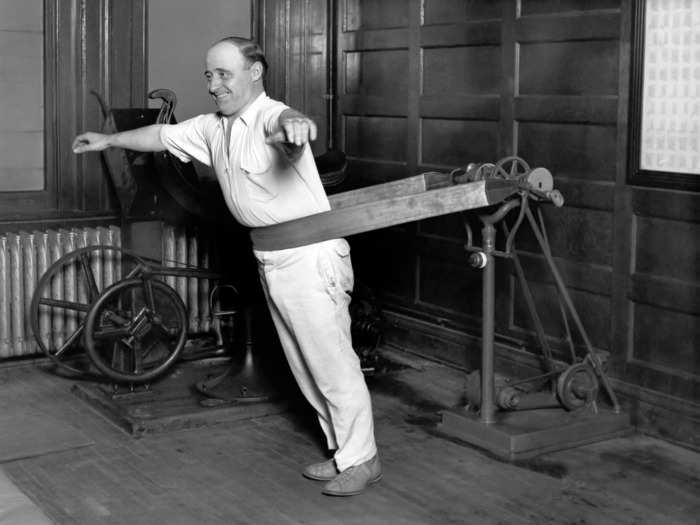
There have been a number of fitness trends that seem bizarre today.New York Daily News Archive/Getty Images
From the ThighMaster to goat yoga, the fitness industry has seen some surprising fads in recent years.
However, people have been using unconventional ways to get fit and look their best for decades.
Dating back to the 20th century, people used elaborate contraptions, painful-looking machinery, and strange poses to get their ideal body.
Here are just some of the most surprising ways people exercised over the past 100 years.

Although the vibrating exercise belt was invented in the 1800s, it didn't become popular until the 1930s and again in the 1950s, according to the Kansas Historical Society. The idea was to vibrate fat so fast that it loosened and eventually disappeared.

The belt was intended to fit anyone with any body type.

"It is this speeded up motion of your tissues… 3,200 times a minute… that aids in fast, effective, spot reduction… that actually helps trim down the size of your measurements wherever it embarrasses you most," one advertisement from 1958 claimed, per the Kansas Historical Society.

Like the vibrating belt, the Slendo Massager was another way its manufacturers claimed could shake away fat. The Huffington Post reported that the machine was a cage made of coiled springs that would roll over your stomach, hips, and thighs. All you had to do was stand there and endure it.

The leg rollers were meant to loosen fat from the hip to the ankle.
One advertisement from the 1940s said it was a woman's duty to stay slim — using this equipment, of course.

According to The Atlantic, a large cloth bag was placed over a person's body while an air pump pushed heat into it. This created a sauna-like effect — all while you relaxed and read a book.

Here, a man uses a sauna tub in the 1950s.

Sweating in a sauna is a great way to ease pain and relieve stress.

This electric slimming device stimulated the muscles with a small electric current and was expected to have the same results as exercise. However, instead of actually moving and working up a sweat, users were able to lay down and relax.

Electrotherapy is said to reduce pain, repair muscles, and improve physical function, according to the National Library of Medicine.

While face masks are popular today, the one that became popular in 1955 was used to exercise facial muscles instead of cleansing the skin.
In the '50s, facial exercises were believed to help women lift their faces to look younger.

While some bars today offer a mechanical-bull ride, the fun piece of equipment was once actually used as an exercise device.
A mechanical-bull rental service called Fun Crew USA wrote that the mechanical bull was initially invented to train rodeo competitors, but people quickly learned that it was a way to tone abs and strengthen the core.

This leg spring is similar to today's resistance training.

The human hamster wheel dates back to the 20th century and was used as a form of amusement. But it can also be used as exercise equipment, as it takes some core strength to stay inside as the wheel turns.

Today, the hamster wheel is sometimes still used as a replacement to a treadmill.

The gyro wheel is a kind of gyroscope, which was believed to increase circulation and improve cardiovascular health.

The bongo board was a piece of wood balanced atop a roller. When stepping on either side of the board, the roller would roll from side to side. It was marketed as an individual seesaw that helped you get fit and build your balance skills.

Las Picas was an exercise machine that had two poles attached to a small box. The poles were able to be moved any which way, allowing you to get creative in your movements.

The treadmill was initially intended for prison inmates and has gone through many iterations since its invention in 1818. PBS reported that the treadmill was first created to make prisoners climb an endless staircase as a means of reform but, eventually, it caught on as a fitness device.
Today the treadmill is considered a staple in every gym.

The invention of a nautical treadmill combined stationary exercise with water sports.

In this photo, movie star Helen Chadwick uses the rowing machine to stay fit. The machine was also one of the few exercise machines to be included in the gymnasium of the Titanic, which sank in 1912.

With a series of pulleys and tightropes, you were able to get a full-body exercise.

According to the company's website, Nautilus started mass producing fitness equipment that focused on resistance training.
One of the most popular devices was the Slender Bender, which resembled a lawn chair and involved the person just lying down and sitting up. The Prone Cycle, pictured above, helped people work on their legs while lying down.


Repetitive movements were believed to strengthen, firm, and raise certain parts of the body, according to a vintage workout video from the 1940s. This method shares some aspects of today's barre workouts.

Many of these exercises were simple stretches.

The shoulder stand was believed to increase circulation throughout the body. It's now a popular pose in yoga.


While dance exercise classes like Zumba are still popular today, the outfits and style of dance may look a little different.

Copyright © 2024. Times Internet Limited. All rights reserved.For reprint rights. Times Syndication Service.